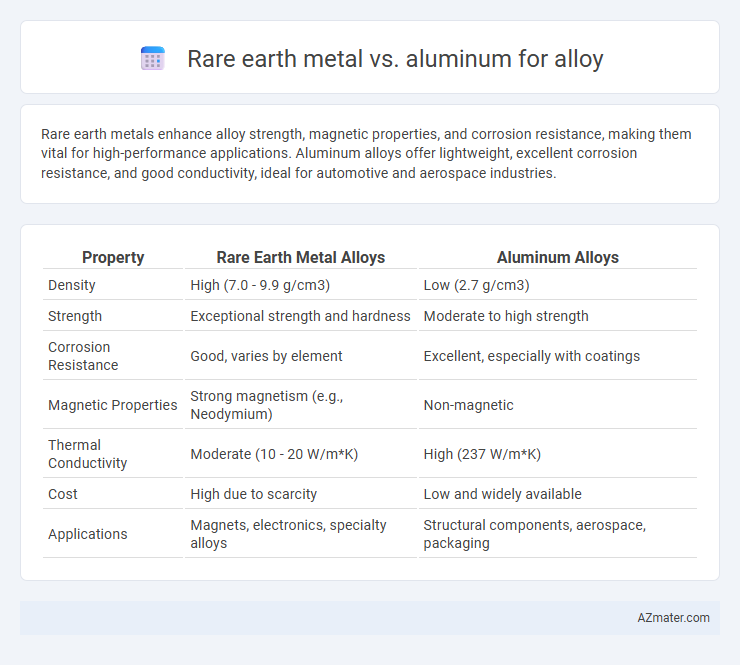Rare earth metals enhance alloy strength, magnetic properties, and corrosion resistance, making them vital for high-performance applications. Aluminum alloys offer lightweight, excellent corrosion resistance, and good conductivity, ideal for automotive and aerospace industries.
Table of Comparison
| Property | Rare Earth Metal Alloys | Aluminum Alloys |
|---|---|---|
| Density | High (7.0 - 9.9 g/cm3) | Low (2.7 g/cm3) |
| Strength | Exceptional strength and hardness | Moderate to high strength |
| Corrosion Resistance | Good, varies by element | Excellent, especially with coatings |
| Magnetic Properties | Strong magnetism (e.g., Neodymium) | Non-magnetic |
| Thermal Conductivity | Moderate (10 - 20 W/m*K) | High (237 W/m*K) |
| Cost | High due to scarcity | Low and widely available |
| Applications | Magnets, electronics, specialty alloys | Structural components, aerospace, packaging |
Introduction to Rare Earth Metals and Aluminum in Alloy Production
Rare earth metals, including elements like neodymium and dysprosium, are critical in enhancing the magnetic, thermal, and mechanical properties of alloys used in high-performance applications such as electronics and aerospace. Aluminum alloys, valued for their lightweight, corrosion resistance, and excellent strength-to-weight ratio, dominate industries like automotive and construction where durability and weight reduction are essential. Combining rare earth metals with aluminum in alloy production results in materials with superior strength, improved thermal stability, and enhanced wear resistance, making them ideal for advanced engineering challenges.
Chemical and Physical Properties Comparison
Rare earth metals exhibit unique chemical properties such as high reactivity with oxygen and nitrogen, leading to enhanced corrosion resistance and improved high-temperature stability in alloys compared to aluminum. Physically, rare earth alloys often feature higher melting points and magnetic properties, while aluminum alloys provide superior lightweight characteristics with excellent thermal and electrical conductivity. The integration of rare earth elements into aluminum alloys can significantly improve strength, wear resistance, and fatigue life without substantially increasing weight.
Strength and Durability: Rare Earth Metal vs Aluminum Alloys
Rare earth metal alloys exhibit superior strength and durability compared to aluminum alloys due to their unique atomic structures that enhance hardening mechanisms and corrosion resistance. Aluminum alloys, while lightweight and corrosion-resistant, generally lack the elevated tensile strength and wear resistance found in rare earth metal alloys, making them less suitable for high-stress applications. The integration of rare earth elements into alloys significantly improves mechanical properties, resulting in enhanced structural performance and extended lifespan.
Corrosion Resistance in Varying Environments
Rare earth metals in alloys significantly enhance corrosion resistance by forming stable oxide layers that protect against degradation in harsh environments, including marine and acidic conditions. Aluminum alloys alone can resist corrosion well due to natural passivation but are more susceptible to pitting and stress corrosion cracking in chloride-rich environments. Incorporating rare earth elements such as cerium or lanthanum into aluminum alloys improves corrosion resistance by reducing localized corrosion and stabilizing the protective oxide film across varying environmental conditions.
Lightweight Applications: Aluminum’s Competitive Edge
Rare earth metals enhance aluminum alloys by improving strength, corrosion resistance, and thermal stability, crucial for aerospace and automotive industries. Aluminum's low density (2.7 g/cm3) combined with rare earth elements results in lightweight materials ideal for fuel efficiency and performance. These optimized aluminum alloys maintain a competitive edge by balancing weight reduction with mechanical durability in lightweight applications.
Cost Analysis and Economic Viability
Rare earth metals significantly increase alloy costs due to their scarcity and complex extraction processes, making them less economically viable for large-scale applications compared to aluminum. Aluminum alloys benefit from abundant raw materials and well-established recycling systems, resulting in lower production costs and enhanced cost-effectiveness. Market demand trends and price volatility of rare earth elements further challenge their competitive positioning against aluminum in cost-sensitive industries.
Environmental Impact and Sustainability
Rare earth metals in alloys often require extensive mining processes that result in significant ecological disturbances and hazardous waste, impacting biodiversity and water quality. Aluminum alloys, by contrast, benefit from abundant recyclability and lower energy consumption during processing, reducing their overall carbon footprint. Choosing aluminum for alloy production enhances sustainability due to its efficient recycling infrastructure and minimal long-term environmental degradation compared to rare earth-based alternatives.
Processing and Manufacturing Differences
Rare earth metals in alloys enhance magnetic and high-temperature properties but require complex extraction and purification processes compared to aluminum, which is abundant and easier to refine. Aluminum alloys benefit from well-established, energy-efficient manufacturing techniques like extrusion and rolling, whereas rare earth alloys often need specialized melting and casting methods to maintain element stability. The differing thermal and chemical properties demand tailored processing conditions, making rare earth metal alloys more costly and technically challenging to produce than aluminum alloys.
Industry Applications: Aerospace, Automotive, and Electronics
Rare earth metals such as neodymium and dysprosium enhance alloy strength, corrosion resistance, and magnetic properties, making them critical in aerospace turbine blades and electric vehicle motors, whereas aluminum alloys are favored for their lightweight and high thermal conductivity in aircraft structures and automotive body panels. In electronics, rare earth-doped aluminum alloys improve electromagnetic shielding and thermal management, supporting miniaturization and durability. The aerospace industry relies on rare earth alloys for high-performance applications requiring extreme temperature resistance, while aluminum's recyclability and cost-effectiveness drive its extensive use in automotive manufacturing and consumer electronics casings.
Future Trends and Innovations in Alloy Development
Rare earth metals are increasingly integrated into aluminum alloys to enhance mechanical strength, corrosion resistance, and heat tolerance, driving advancements in aerospace and electric vehicle industries. Innovations focus on optimizing the microstructure through precise additive manufacturing techniques and nanoalloying with rare earth elements like neodymium and dysprosium to improve thermal stability and magnetic properties. Emerging trends highlight sustainable extraction processes and recycling of rare earth metals to reduce environmental impact while maintaining alloy performance in next-generation lightweight and high-strength materials.

Infographic: Rare earth metal vs Aluminum for Alloy
 azmater.com
azmater.com